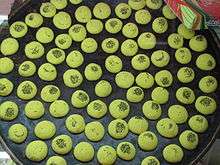Nan-e berenji
Nan-e berenji (Persian: نان برنجی), also called shirini berenji, is an Iranian rice-flour cookie originating from Kermanshah.[1] Nan-e berenji literally translates to "rice bread". It is often flavored with cardamom, garnished with poppy seeds and formed into flat disks. They are usually white, but sometimes tinted yellow.[2]
 | |
| Type | cookie |
|---|---|
| Place of origin | |
| Main ingredients | rice flour, sugar, egg, cardamom |
Seven Sweets
According to legend, King Jamshid discovered sugar on the Persian new year, Nowruz. Therefore, there is the custom to celebrate Nowruz with seven sweet foods, in addition to the traditional other 7 foods at the Haft-sin.[3] The seven sweets are:
- noghl, sugar-coated almonds
- Persian baklava, pistachio almond pastry
- nan-e berenji, rice cookies
- nan-e badami, almond cookies
- nan-e nokhodchi, chick-pea cookies
- sohan asali, honey almonds
- nan-e gerdui, walnut cookies
gollark: Should I turn off the "dump bucketloads of data onto users" function?
gollark: Well, okay, do that.
gollark: Read messages, read message history, send messages?
gollark: https://discordapp.com/oauth2/authorize?&client_id=509849474647064576&scope=bot&permissions=68608
gollark: OH.
References
- Bāzargān, Ṣoḡrā (December 15, 1993). Cookies. VI (Last Revision: October 28, 2011 ed.). Encyclopædia Iranica. pp. 244–246.
- Marks, Gil. (2010). Encyclopedia of Jewish food. Hoboken, N.J.: Wiley. ISBN 978-0-544-18631-6. OCLC 849738985.
- "A Cookie for Every Country: Iran: Nan-e Nokhodchi". A Cookie for Every Country. Retrieved 2020-05-26.
External links
This article is issued from Wikipedia. The text is licensed under Creative Commons - Attribution - Sharealike. Additional terms may apply for the media files.